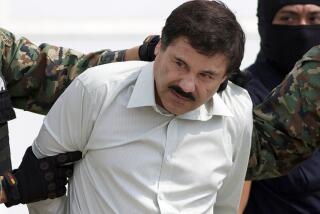A New Twist in Case Cloaked in Mystery and Money
- Share via
PILAR, Argentina — For more than a year, the Argentine public has been mesmerized by the slaying of socialite Maria Marta Garcia Belsunce, a true-life drama with details seemingly borrowed from an Agatha Christie novel.
Moments after Belsunce’s body was discovered in her bathtub in October 2002, the leading suspects gathered in the living room of her villa in this Buenos Aires suburb to discuss what they should do: her husband, her brother, her brother-in-law, her doctor, even her masseuse.
Now a prosecutor has stepped forward to say who among them will be charged in Belsunce’s killing. But the alleged motive is an unexpected and disturbing twist that is more “Sopranos” than Christie: Belsunce was killed, the prosecutor alleges, not out of jealously or greed, but to cover up the dealings of Mexico’s Juarez drug cartel.
Pilar prosecutor Diego Molina Pico said Belsunce’s stockbroker husband was laundering money for the cartel. Tentacles of the cartel’s billion-dollar business span the Western Hemisphere.
Belsunce, 50, had either discovered her husband’s dirty dealings, the prosecutor says, or decided that she could no longer be his co-conspirator.
Belsunce’s husband, Carlos Carrascosa, killed his wife with the help of two unnamed accomplices, the indictment charged. And nearly everyone else who had gathered in the villa in the hours after Belsunce’s body was found -- including the brother and the masseuse -- was charged with trying to cover up the crime.
“Enormous quantities of ill-gotten money from the Juarez cartel’s operations in Argentina have purchased the consciences” of the accused, Molina Pico said in his Feb. 16 indictment. Fear of the cartel, he added, “imposed silence upon those tied to this crime.”
Attorneys for Carrascosa and the other defendants denounced the indictment as a “fantasy” and called the prosecutor “a spinner of fables.” And a judge who has conducted a long-running investigation of the cartel’s activities in Argentina said the indictment had not convinced him that the cartel was linked to Belsunce’s slaying.
It was not the first strange twist in the case, which began with the discovery of Belsunce’s body in the Carmel Country Club, one of several gated communities in Pilar.
Her obituaries said she was the victim of a bathtub accident. But an ambulance driver told investigators that he had seen at least three holes in her head. More than a month after her death, her body was exhumed from the famous Recoleta Cemetery, where dozens of leading lights of Argentine society are buried.
An autopsy discovered five bullets in her skull. Returning to the Belsunce home, Molina Pico and his investigators found a bullet fragment in the plumbing: Family members had flushed it down the toilet, saying they thought that it was a broken “connector rod.”
“You lied to me,” Molina Pico told Carrascosa and the other family members.
Suspicion immediately centered on Carrascosa and the two doctors who had examined Belsunce, one of whom had signed a death certificate listing her cause of death as “non-traumatic cardiac arrest.”
Molina Pico subpoenaed everyone who had been in Belsunce’s villa in the hours after her death. As he painstakingly sorted through their tangled stories, the Argentine media began to openly speculate about who had killed Belsunce and why.
The magazine Veintitres asked half a dozen mystery writers and novelists to create fictional narratives about “the most impassioned private murder of recent decades.”
Novelist Federico Andahazi wrote an imaginary court document in which a fictional witness gives her account of the crime: “Swearing to tell the truth, the whole truth and nothing but the truth, the witness declares that she kissed the victim.”
Other writers spun fictional stories involving the Argentine intelligence service and assorted family members. One writer gave voice to Belsunce’s dog, the only known witness of the crime.
Not one mentioned the Juarez cartel.
According to media reports here, an anonymous letter that Molina Pico received in January and a cryptic notation in a file on Belsunce’s computer led the prosecutor to link the case to the Mexican drug trade.
The indictment alleges that Carrascosa and Belsunce had dealings with a bank linked to the cartel. A complex series of family and business relationships links another defendant in the case -- Nora Burgues de Taylor, a neighbor who disposed of Belsunce’s bloody clothes -- to the cartel.
Belsunce “formed part of, or was very informed of, the Mafia activity, and of the movement of illicit funds,” the indictment said, and was killed so she would not reveal it to the authorities.
Carrascosa, arrested and released last year, could be placed in custody again soon.
His wife’s body lies once again in Recoleta Cemetery, not far from that of another famous Argentine whose body was buried once, exhumed and then buried again: Eva “Evita” Peron.
More to Read
Sign up for Essential California
The most important California stories and recommendations in your inbox every morning.
You may occasionally receive promotional content from the Los Angeles Times.











